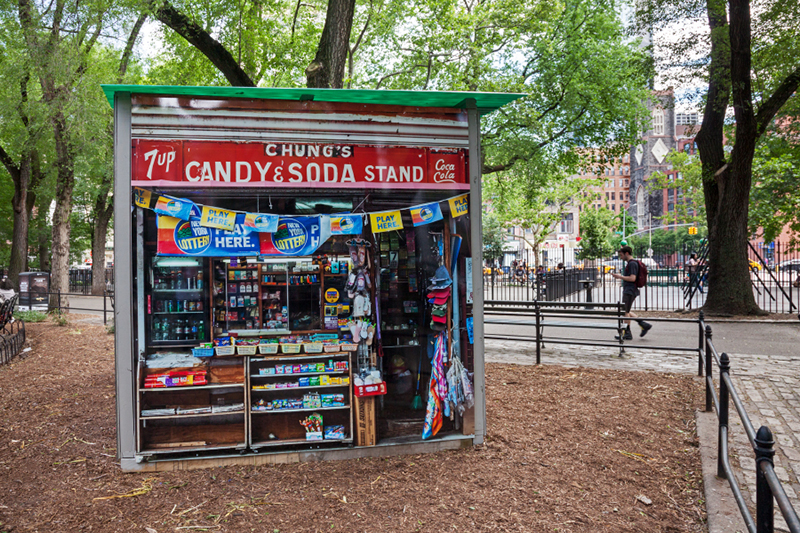Vintage wall advertising and store signs have comparable status, at least for me, to Greek and Roman statuary. Both mediums either sold or celebrated stuff. If Instagram is any measure, it is also a photographic obsession. For various civic, voyeuristic, and nostalgic reasons James and Karla Murray are New York’s sign and storefront docu-saviors. They have been photographing the vanishing cityscapes and documenting in their books, Store Front: The Disappearing Face of New York, New York Nights and Store Front II- A History Preserved, and recently constructed art installation in Manhattan’s Seward Park to commemorate what they call “Mom and Pop” storefronts, which have certainly defined a large portion of the City since the 19th century.
Facing increasing rents, each year more of these quotidian storefronts close and are replaced by chain stores, banks, and trendy emporia. Some buildings are converted into a luxury condos, but if the location has a small footprint or undesirable locale, these spaces often remain vacant for years.

In 2017 the NYC Parks Department awarded the “UNIQLO Park Expression Grant” for Seward Park to the Murrays. It was a chance to install near life-size prints of their storefront photography on a 3-D structure approximating a free-standing shop. “It was great idea to help draw attention to the fact that many neighborhood shops have been disappearing from the Lower East Side,” they told me. “The purpose of our installation is to help raise awareness of the importance of ‘Mom-and-Pop’ stores to the community.”
On one side of the wood-framed installation is “Cup & Saucer,” a 1940s era luncheonette located just down the street from Seward Park that was forced to close in July 2017 after the rent was increased from $8,200 a month to $15,800 a month. “It was a very special place, run by two Greek-Americans who purposely kept their prices reasonable so that it could act as a neighborhood gathering spot.” The other sides feature a typical visually cluttered deli/“Superette,” the famous “Katz’s Delicatessen” entrance and “Chung’s Candy & Soda Stand.”
Each image is a deceiving trop l’oeil of the real thing that they call a “big-ature.” It is a mix-up of aesthetics of unique vernacular lettering, typefaces, elements of mid-century modern, art deco, and classic New York styles — “a true representation of the varied immigrants who founded these shops.”

It is, of course, inevitable that modernity subsumes the old and the Murrays understand that New York is always changing and evolving. Nonetheless, they were alarmed at the quick rate of change with these neighborhood stores throughout all five boroughs. “We also never realized how heavily the deck was stacked against an independently-owned small business and how a way of life for many residents is rapidly disappearing.”
The combination of gentrification and skyrocketing rents are worrisome to shop owners. Those who are fortunate enough to own the entire building are anxious about not having anyone in their families to take over the businesses when they retire, bringing to an end a long line of family tradition. Moreover, New York City’s increasingly restrictive rules and regulations over store signs and awnings demand huge permit fees to retain neon signs or large overhanging signs. The city is no longer issuing new permits while strict zoning rules in some communities are prohibitive anyway. Older stores are often forced to comply with these new regulations and must modernize, despite the owners’ wishes.

The Murrays note that the neighborhood store has always been a foothold for new immigrants and a comfortable place where familiar languages are spoken and ethnic foods and culture are present. “These shops are lifelines for their communities, vital to the residents who depend on them for a multitude of needs. They set the pulse, life, and texture of their communities. Not only are these modest institutions falling away in the face of modernization and conformity, the once unique appearance and character of our colorful streets suffer in the process.”
In the 1990s they noticed the alarming rate at which these shops were disappearing. “The whole look and feel of the neighborhood had changed and much of its individuality and charm had gone.”
They made it their mission to make this “artistic intervention” to help draw attention to and preserve the small shops whose existence is essential to the unique and colorful atmosphere of the city’s streets. “But even though the project was initially primarily driven by visual aesthetics, after speaking with only a handful of the storeowners, the scope of the project became larger as we discovered that many of the shop owners had fascinating stories to share about the joys and struggles of surviving as a family business in New York City.” With New York’s rapid development in time.

